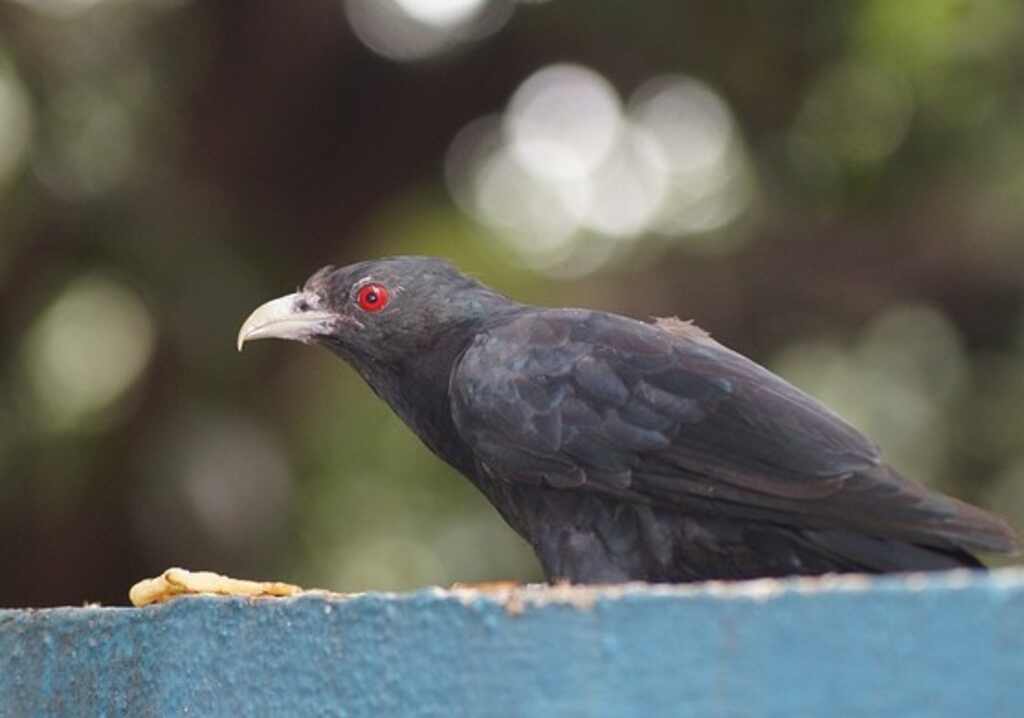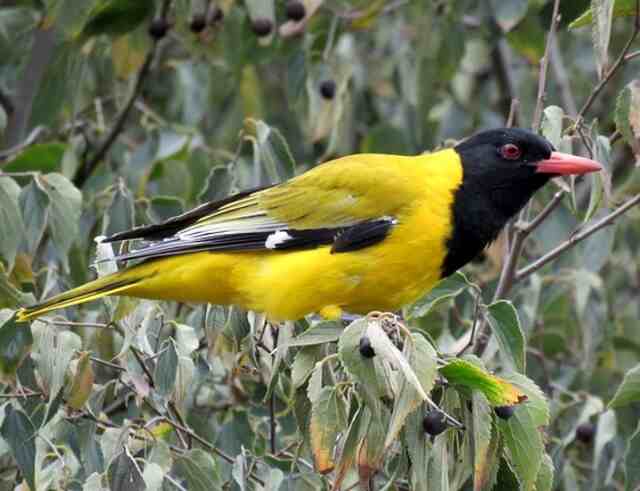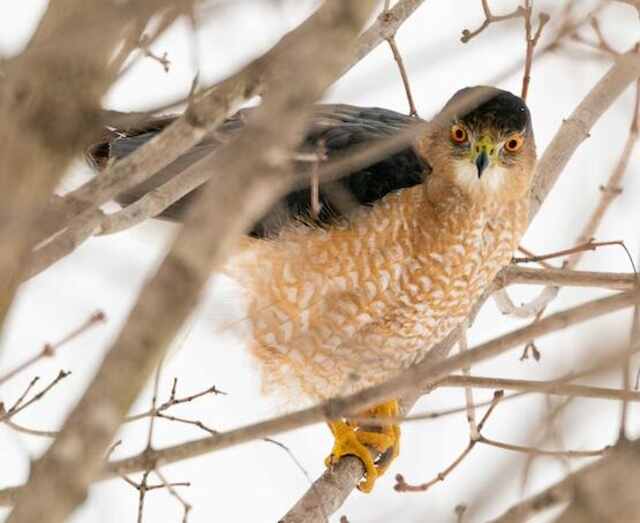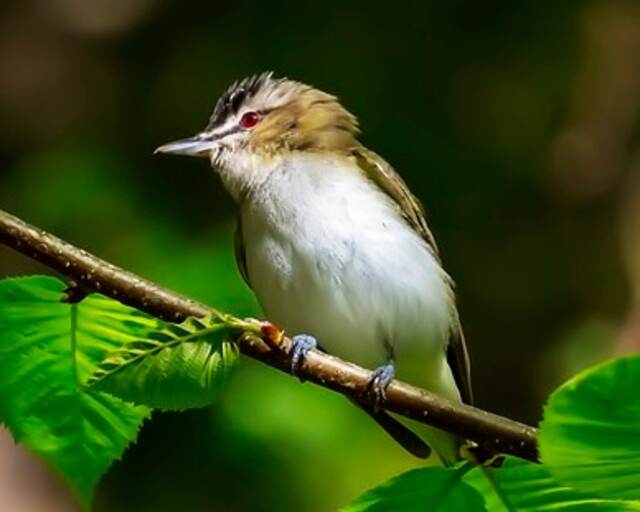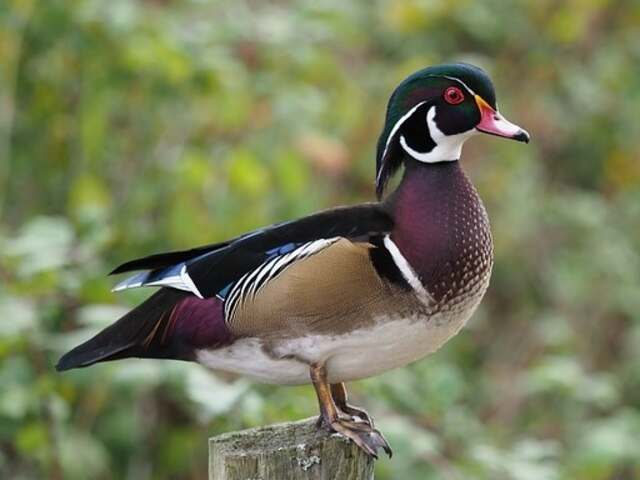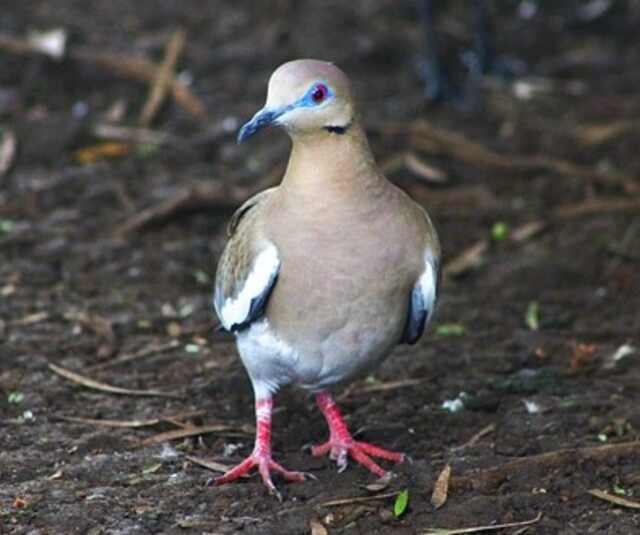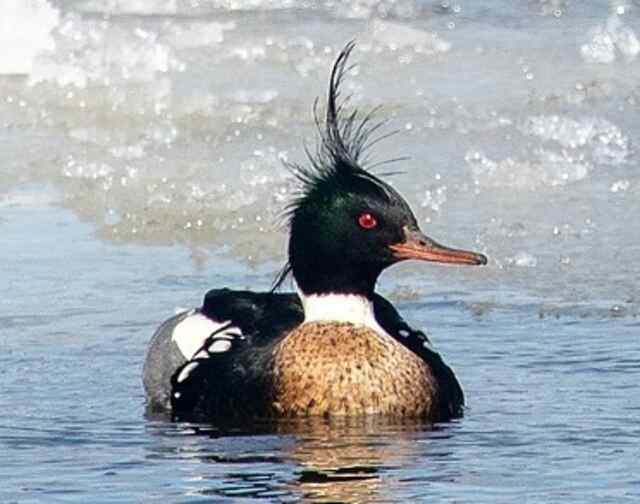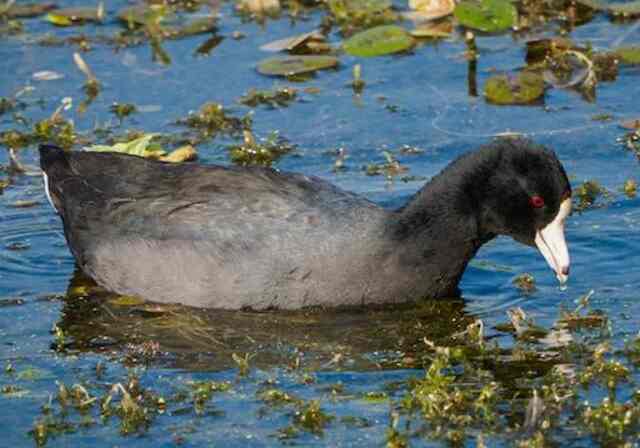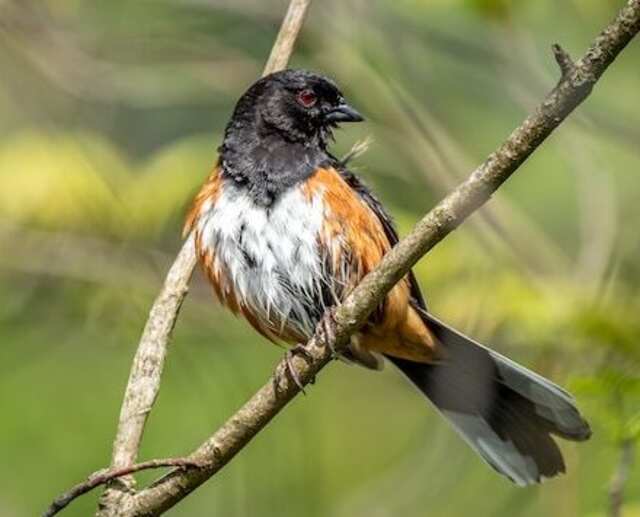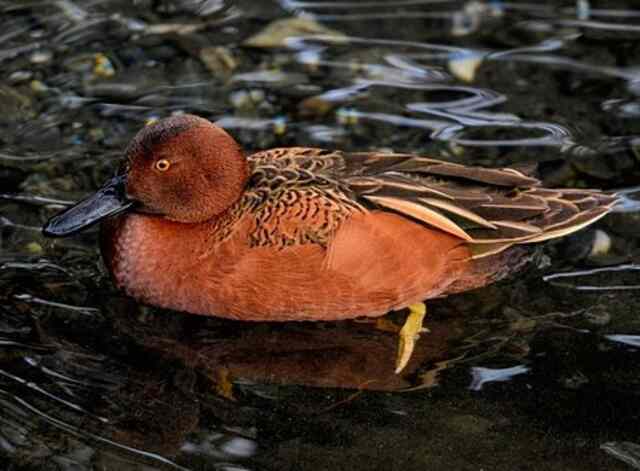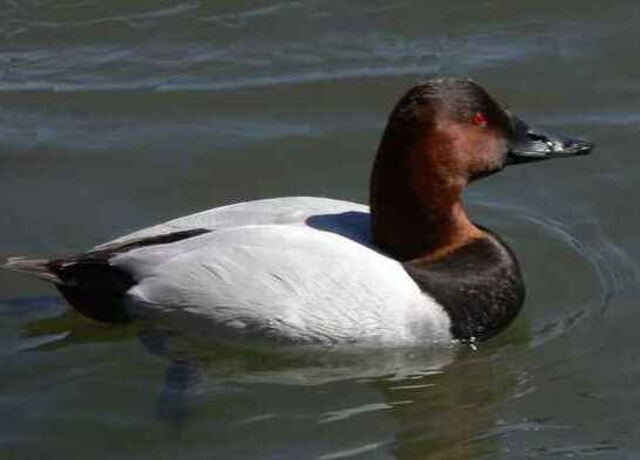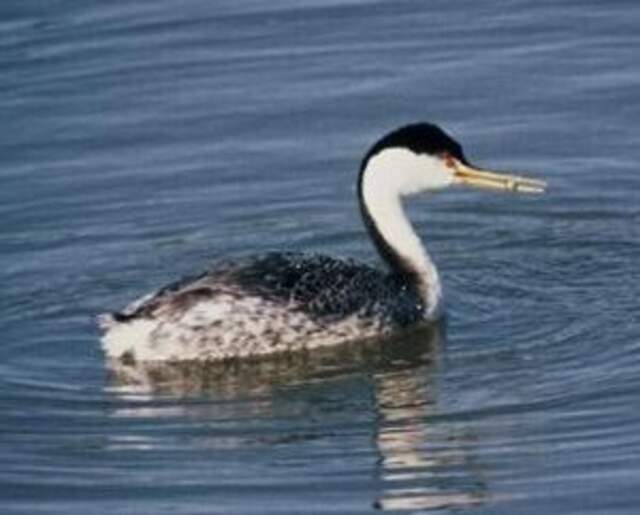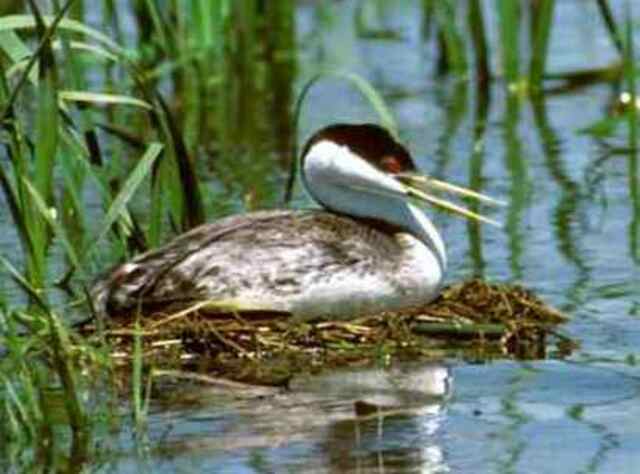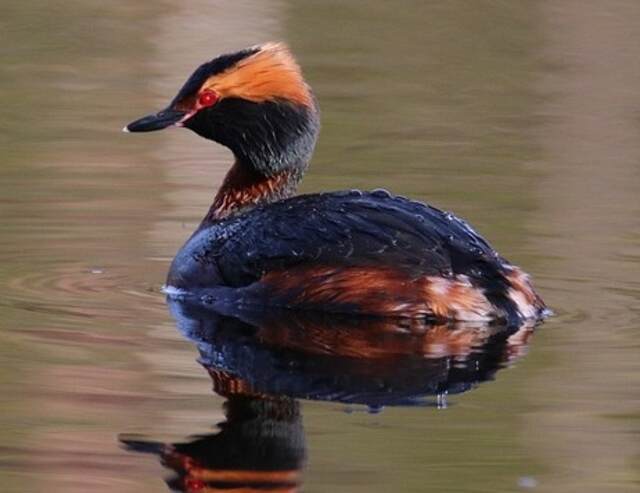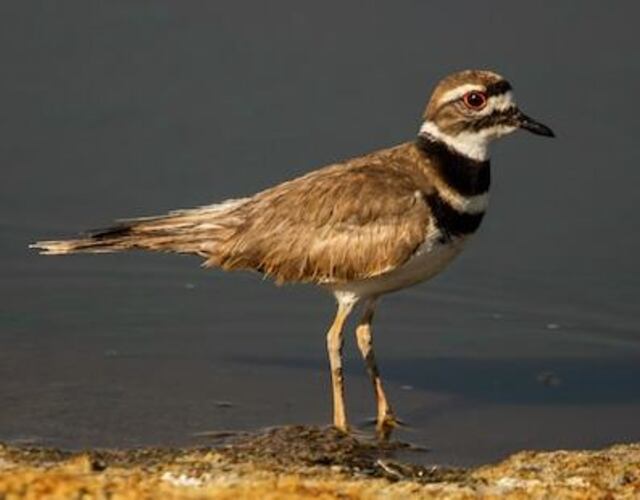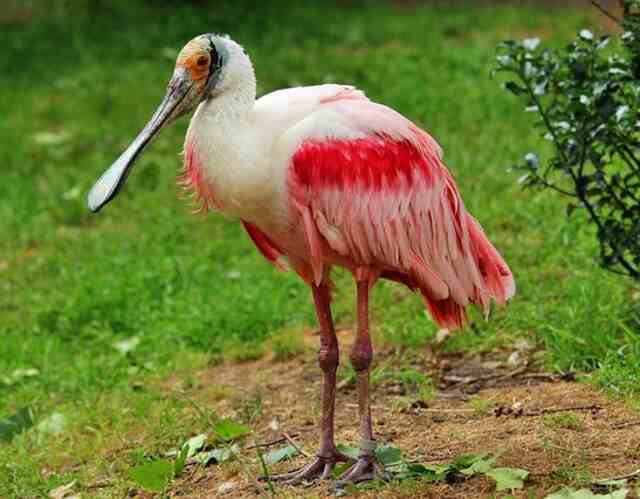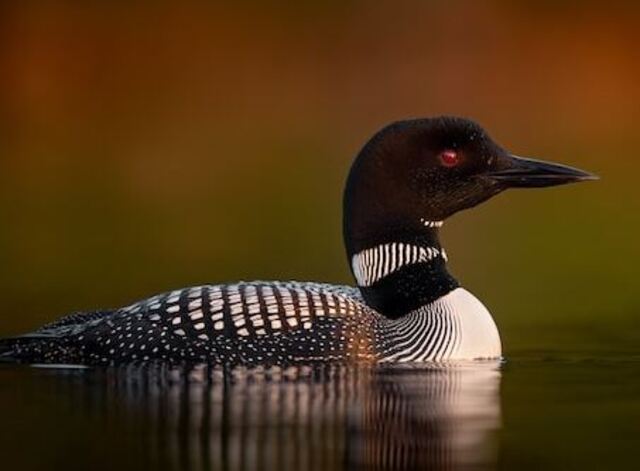Birds are some of the most fascinating creatures on the planet, with their vibrant colors, unique calls, and impressive abilities. Among the many features that make birds special are their eyes.
While most birds have black or brown eyes, there are some species that stand out with their striking red eyes. These red-eyed birds are not only visually stunning, but they also offer a glimpse into the diversity of the avian world.
In this article, we will explore 21 remarkable birds with red eyes, their characteristics, habitat, distribution range, and the functions of their red eyes. Get ready to discover some of the most fascinating birds on the planet!
Table of Contents
- 1 What Makes Red Eyes Unique in Birds?
- 2 Why Birds Have Red Eyes?
- 3 Functions of Red Eyes
- 4 Types of Birds with Red Eyes
- 4.1 Cooper’s Hawks
- 4.2 Red-eyed Vireo
- 4.3 Black-crowned Night-heron
- 4.4 Wood Duck
- 4.5 White-winged Dove
- 4.6 Red-breasted Merganser
- 4.7 White-tailed Kite
- 4.8 Phainopepla
- 4.9 American Coot
- 4.10 Spotted Towhee
- 4.11 Eastern Towhee
- 4.12 Cinnamon Teal
- 4.13 Canvasback
- 4.14 Great Crested Grebe
- 4.15 Clark’s Grebe
- 4.16 Western Grebe
- 4.17 Horned Grebe
- 4.18 Killdeer
- 4.19 Roseate Spoonbill
- 4.20 Common Loon
- 4.21 Zebra Finch
- 5 Conclusion
- 6 Author
What Makes Red Eyes Unique in Birds?
Red eyes are a unique characteristic found in some bird species, including hawks, eagles, and owls. Unlike humans, birds have a variety of pigments in their eyes, which can create different colors. One of the pigments responsible for the red coloration in bird eyes is carotenoids, which can also be found in fruits and vegetables.
Additionally, the structure of bird eyes is different from that of humans, with some species having a higher density of photoreceptor cells, which can improve visual acuity.
Why Birds Have Red Eyes?
The reason why birds have red eyes can vary depending on the species. In some cases, it may be due to genetic factors or their diet, while in others, the red coloration is thought to be an adaptation that provides specific advantages. Certain birds can develop red eyes due to changes in their genes that lead to decreased melanin production.
As a result, the blood vessels in their iris become more visible, giving their eyes a pinkish red hue. However, red eyes in some birds may also indicate the presence of an eye infection.
Functions of Red Eyes
Communication
Red eyes can also be used as a form of communication between birds. For example, in some species of eagles, the color of the eyes can change depending on the bird’s mood or level of aggression. In other species, such as hawks, the red coloration may be used to intimidate rivals or attract potential mates.
Attracting Mates
In some bird species, such as the house finch, males with redder eyes are more attractive to females. This preference may be due to the association of red coloration with health and vitality.
Thermoregulation
In some species of birds, such as the flamingo, the red coloration in the eyes may serve as a form of thermoregulation. The increased blood flow to the eye region can help dissipate heat and regulate body temperature.
Camouflage
In some species, such as nocturnal owls, the red coloration may serve as a form of camouflage. Red eyes can blend in with the surrounding feathers and make the eyes less noticeable in low light conditions.
Types of Birds with Red Eyes
Cooper’s Hawks
Cooper’s Hawks are medium-sized birds of prey found throughout North America, from southern Canada to northern Mexico. They have a distinctive, rounded tail and short, broad wings, which make them agile hunters capable of chasing prey through dense forests. Cooper’s Hawks prefer woodland habitats and are commonly found in urban areas where they feed on smaller birds, squirrels, and other prey.
Their diet also includes reptiles, insects, and occasionally, small mammals. One of the most striking features of Cooper’s Hawks is their red eyes, which are thought to aid in hunting. The coloration is due to the presence of carotenoid pigments in the iris, which may help to enhance visual acuity and allow the hawk to spot prey more easily. Additionally, the red eyes may serve as a communication tool, as a means of intimidating rivals or attracting potential mates.
Read more: 20 Cooper’s Hawk Fun Facts (with Photos & Information)
Red-eyed Vireo
The Red-eyed Vireo is a small passerine bird native to the Americas, known for its distinctive plumage and vocalizations. These birds have olive-green upperparts, a grayish-white breast, and a bold white eyebrow stripe. As their name suggests, they have striking red eyes. Red-eyed Vireos are found throughout most of North and South America, breeding in deciduous forests and woodlands, and wintering in Central and South America.
They have a varied diet, feeding on insects, spiders, and small fruits. The red eyes of these birds are thought to aid in catching prey, as they allow for better visual acuity in low light conditions. Additionally, the red coloration may play a role in social signaling and mate selection.
Black-crowned Night-heron
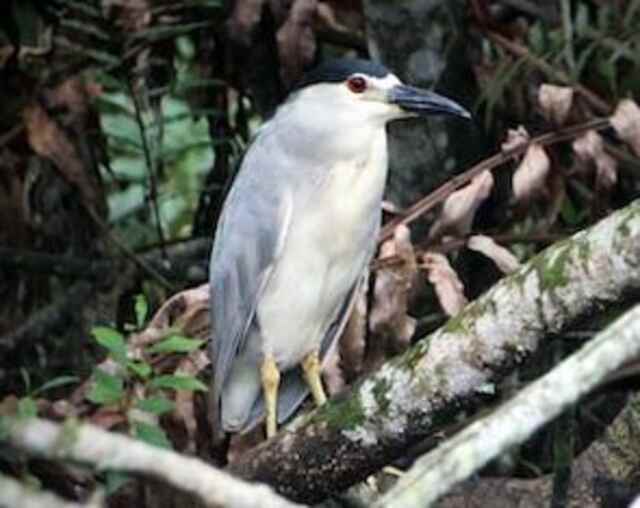
The Black-crowned Night-heron (Nycticorax nycticorax) is a medium-sized heron found across much of the world. They are distinguished by their black crown and back, white underparts, and red eyes. They have a broad distribution range, inhabiting both freshwater and saltwater habitats, including marshes, swamps, and wooded streams. Their diet consists of a variety of aquatic creatures, including fish, crustaceans, and insects.
The red eyes of the Black-crowned Night-heron are thought to play a role in facilitating their nocturnal feeding habits by enhancing their vision in low-light conditions. These red eyes also serve as a form of communication, with the intensity of their color indicating aggression or fear. Overall, the unique characteristics of the Black-crowned Night-heron make it a fascinating and important species in the ecosystems it inhabits.
Wood Duck
The Wood Duck, also known as the Carolina Duck, is a beautiful and unique species of waterfowl found in North America. They have strikingly colorful plumage with a mix of iridescent green, blue, purple, and white. Their distribution range includes eastern North America, from southern Canada to the Gulf of Mexico. They prefer habitats near freshwater sources, including wooded swamps, ponds, and marshes.
Their diet consists mainly of seeds, fruits, and aquatic invertebrates. Wood Ducks have red eyes due to the presence of carotenoid pigments in their diet, which are deposited in their eye tissue. These red eyes are believed to help with visual perception in low light conditions and attract potential mates. Additionally, the red eye coloration may serve as a form of communication between individuals during social interactions.
White-winged Dove
The White-winged Dove (Zenaida asiatica) is a medium-sized bird species native to North, Central, and South America. It is known for its distinctive white wing patches and reddish-brown body. White-winged doves are commonly found in arid and semi-arid habitats, such as deserts, open woodlands, and urban areas. The primary components of their diet are seeds, fruits, and insects.
The red eyes of white-winged doves are due to the presence of a specialized pigment called pteridine, which helps them see better in bright sunlight. The red coloration also serves as a sign of their breeding readiness and as a means of communication with other doves. Overall, the White-winged Dove is a fascinating bird with unique adaptations that enable it to thrive in diverse environments.
Red-breasted Merganser
The Red-breasted Merganser (Mergus serrator) is a species of diving duck that inhabits the coastal waters of North America, Europe, and Asia. It is characterized by its long, thin, serrated bill, shaggy crest, and striking red eyes. They are primarily found in marine and estuarine habitats, but can also be found on freshwater lakes and rivers during the breeding season. Their diet consists mainly of fish, crustaceans, and mollusks, which they catch by diving underwater.
The red coloration of their eyes is due to a high concentration of blood vessels, which increases their visual acuity underwater. This allows them to see and catch their prey more effectively, especially in low-light conditions. Additionally, the red eyes are used in courtship displays, where males display their red eyes to attract mates.
White-tailed Kite
The White-tailed Kite (Elanus leucurus) is a small, graceful bird of prey found in North and South America. They have a distinct appearance with a white head, gray wings, and a white tail. Their habitat ranges from marshes, grasslands, savannas, and agricultural fields. Their diet mainly consists of small mammals, rodents, and reptiles. One unique characteristic of the White-tailed Kite is their striking red eyes.
The red coloration is due to a high concentration of blood vessels in their eyes, which helps them see better in low light conditions. They also use their red eyes to communicate with other kites during territorial disputes or courtship displays. Additionally, the red coloration may serve as a signal of health and vitality to potential mates.
Phainopepla
The Phainopepla is a unique songbird species found in the southwestern United States and Mexico. Known for their striking appearance, they have glossy black plumage, a distinctive crest, and bright red eyes. They inhabit a variety of habitats including deserts, scrublands, and oak woodlands. They mainly eat insects and berries as their diet. The red color of their eyes is due to the presence of a carotenoid pigment called astaxanthin, which is also found in shrimp and other crustaceans.
It is believed that these bright red eyes play a role in mate selection and territorial defense. They also aid in locating food and enhancing visual contrast in low-light conditions. Overall, the Phainopepla is an intriguing and beautiful bird with unique adaptations that allow it to thrive in its environment.
American Coot
The American Coot, also known as the mud hen, is a bird species that belongs to the rail family. They are widely distributed across North America, ranging from Alaska to Panama, and can be found in a variety of habitats, including marshes, ponds, and lakes. They are known for their unique physical characteristics, including their chicken-like appearance, dark gray feathers, and distinctive white beaks.
The American Coot primarily feeds on aquatic vegetation, insects, and small fish, using their sharp claws to grab their prey. One of the most striking features of the American Coot is its red eyes. These bright red eyes are thought to help the birds see better in low light conditions, and may also play a role in communication and mate selection. Overall, the American Coot is an interesting and distinctive bird species with a unique set of physical and behavioral characteristics.
Spotted Towhee
The Spotted Towhee is a medium-sized bird that belongs to the family Emberizidae. They have a black head, back, and tail, with white spots on their wings and a rusty-red side. These birds can be found throughout western North America, ranging from southern Alaska to central Mexico. They prefer to live in shrubby areas, brushy woodlands, and forests with dense undergrowth.
The Spotted Towhee feeds on seeds, insects, and fruits, and can often be seen scratching through leaves and debris on the ground. Their red eyes are due to the presence of carotenoid pigments, which are also responsible for the bright colors of their feathers. These red eyes are used for communication with other birds, as well as for detecting predators and maintaining social hierarchies.
Read more: How to Attract Towhee to your Backyard? Expert Tips!
Eastern Towhee
The Eastern Towhee is a distinctive bird found throughout much of eastern North America. This species is characterized by its striking black upper body, rusty sides, and white belly. They have a bold white patch on their wings that flashes when they fly. Eastern Towhees prefer dense understory vegetation in forests, brushy areas, and shrublands as their habitat. Their diet consists of a mix of seeds, insects, and fruits.
One unique feature of the Eastern Towhee is their bright red eyes. It is believed that these red eyes may help with communication between individuals of the same species, as well as aiding in detecting predators in low light conditions. The red eyes may also serve as a way to intimidate rivals during territorial disputes.
Cinnamon Teal
The Cinnamon Teal is a small and colorful duck species that is found mainly in North and South America. These ducks have a distinctive cinnamon-colored plumage on their head, neck, and breast, while the rest of their body is dark brown. They have bright red eyes, which are unique among other species of ducks. The red color of their eyes is due to the presence of carotenoid pigments, which also gives their feathers their bright coloration.
Cinnamon Teals prefer to live in freshwater marshes, ponds, and lakes, and they feed on aquatic plants, seeds, and insects. The red eyes of the Cinnamon Teal serve a functional purpose, helping them to see underwater while they forage for food. The color of their eyes also serves as an important signal for courtship and breeding behaviors.
Canvasback
The Canvasback (Aythya valisineria) is a medium to large-sized diving duck that is easily identified by its reddish-brown head, black chest, and sloping profile. These ducks have a distinctive white body with black markings on the wings and a long, narrow black bill. They are commonly found in freshwater habitats such as lakes, rivers, and marshes throughout North America, from Alaska to the Gulf of Mexico. Canvasbacks are migratory birds, with most of the population breeding in the northern prairies and wintering in the southern United States and Mexico.
Their diet consists mainly of aquatic vegetation, but they also eat small invertebrates and occasionally fish. The red eyes of Canvasbacks are due to the high concentration of blood vessels in their eyes, which helps to regulate their body temperature in cold water. They use their eyes to see underwater, allowing them to locate and catch their prey. Additionally, the red eyes may serve as a visual cue to attract mates during breeding season.
Great Crested Grebe
The Great Crested Grebe (Podiceps cristatus) is a waterbird species with a distinctive black and white crest and red eyes. These birds are found throughout Europe, Asia, and parts of Africa, inhabiting freshwater bodies such as lakes, ponds, and rivers. They feed mainly on fish, but also consume aquatic invertebrates and plant material. The red coloration of their eyes is caused by pigments in their irises, and it is thought to be an adaptation for underwater vision.
Great Crested Grebes spend much of their time diving and swimming underwater, using their keen eyesight to locate prey and avoid predators. In addition to their visual function, the red color of their eyes may also serve as a social signal, indicating the bird’s breeding status and readiness to mate.
Clark’s Grebe
The Clark’s Grebe is a large waterbird native to North America, characterized by its long, slender neck and striking black and white plumage. They are typically found in freshwater lakes, ponds, and marshes throughout the western United States and Canada. Their diet consists primarily of fish, which they catch by diving underwater and swimming with remarkable agility.
One unique feature of Clark’s Grebes is their red eyes, which are thought to play a role in communication and courtship displays. During mating rituals, they will engage in synchronized swimming and head-bobbing, often making eye contact with their partner. The bright red color of their eyes may serve as a visual cue to attract a mate, or to signal aggression or dominance to other individuals.
Western Grebe
The Western Grebe is a large waterbird that can be found in North America, primarily in freshwater lakes and ponds. They are known for their striking appearance, with a long neck and a sleek black and white body. Their diet consists mostly of fish, which they catch by diving underwater. Western Grebes have unique red eyes, which are believed to have multiple functions.
One function is to help with communication between mates, as they can see each other’s eyes from a distance while performing their elaborate courtship dance. The red color may also play a role in attracting mates or deterring predators. In terms of habitat, Western Grebes prefer bodies of water with abundant vegetation and open areas for diving and swimming.
Horned Grebe
The Horned Grebe is a small waterbird species that is known for its distinctive red eyes, which serve a vital function in their survival. These birds are found across North America, Europe, and Asia, breeding in freshwater lakes and ponds and wintering on coastal bays and estuaries. They have a black and white breeding plumage, a sharp-pointed bill, and small, distinctive head crests. They mainly consume small fish, crustaceans, and aquatic insects in their diet.
The red coloration of their eyes is due to the presence of carotenoid pigments, which also give coloration to their bills and head crests. These pigments help to protect their eyes from the harsh sunlight that reflects off the water, allowing them to dive deeper and longer in search of prey. Additionally, the bright red eyes may also serve as a signal of health and fitness to potential mates during breeding season.
Killdeer
The Killdeer is a small, charismatic bird that is commonly found throughout North and South America. It is easily recognizable by its striking plumage and distinct vocalizations. The bird’s characteristic features include a brown back, white belly, and two distinctive black bands across the chest. They inhabit a wide variety of environments, from agricultural fields to rocky shorelines and gravel rooftops.
They primarily consume insects, worms, and other small invertebrates as their diet. The Killdeer’s red eyes are thought to serve several functions, including helping them see in low light conditions and signaling to other birds when they are alarmed or threatened. Additionally, their red eyes may also help attract mates during breeding season by appearing more striking and noticeable.
Roseate Spoonbill
The Roseate Spoonbill is a fascinating bird species found in the Americas, with a distribution range that stretches from the southeastern United States to South America. Known for its unique appearance, the Roseate Spoonbill has a distinctive spoon-shaped bill that it uses to sift through water and mud in search of food. Their habitat includes coastal wetlands, marshes, and swamps.
Their diet consists of fish, crustaceans, insects, and other small aquatic creatures. One interesting characteristic of the Roseate Spoonbill is its red eyes, which are believed to be an adaptation for feeding in low light conditions. These birds use their eyes to locate prey in murky water and to communicate with others of their species. The red coloration of their eyes is due to the presence of carotenoid pigments that help protect their eyes from the sun’s harmful rays.
Common Loon
The Common Loon, which is also known as the Great Northern Diver, is a unique waterbird species that inhabits regions throughout the Northern Hemisphere. These birds are known for their striking black and white plumage, long bodies, and distinctive red eyes. Common Loons are well-adapted to living in aquatic environments and can be found in a variety of habitats, including lakes, rivers, and coastal waters.
Their diet consists mainly of fish, which they catch by diving to depths of up to 200 feet. The red eyes of the Common Loon are thought to play a crucial role in their underwater vision, helping them to locate prey and navigate in murky water. Additionally, the red coloration of the eyes may help to protect them from glare and reflections while diving, allowing the birds to maintain clear vision even in bright sunlight.
Zebra Finch
The Zebra Finch (Taeniopygia guttata) is a small bird belonging to the passerine family and is found in its native habitat of Australia. These birds are known for their distinctive zebra-like stripes on their feathers and their red eyes. They are found across most of Australia, from the coastal areas to the arid inland regions. Zebra Finches are typically found in open grasslands and savannas, as well as in urban areas. They feed primarily on seeds, but also consume insects and fruits.
The red color of their eyes is due to the presence of carotenoid pigments. These pigments help to protect the eyes from damage caused by UV radiation. Zebra Finches use their red eyes to communicate with each other and to establish dominance. The red coloration also serves as a signal to potential mates, indicating good health and genetic quality.
Read more: 9 Best Birdhouse for Finches? (Rated & Tested for 2023)
Conclusion
In conclusion, the collection of 22 birds with red eyes highlights the fascinating and diverse range of adaptations found in nature. From the red-eyed vireo to the zebra finch, each species has evolved unique strategies to thrive in their respective environments.
Whether it’s to attract mates, see better in low light conditions, or deter predators, the red coloration in their eyes serves a vital purpose. Nature’s marvels never cease to amaze us, and these birds with red eyes are a testament to the incredible diversity of life on our planet.
Related Post:

